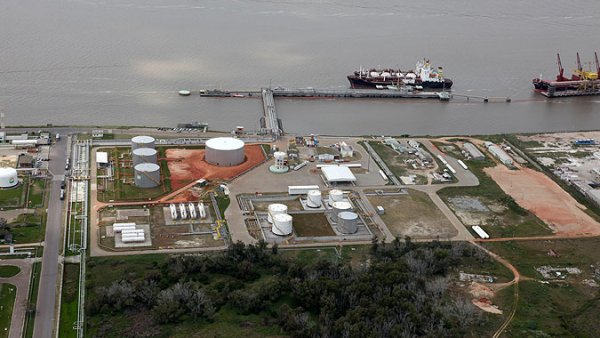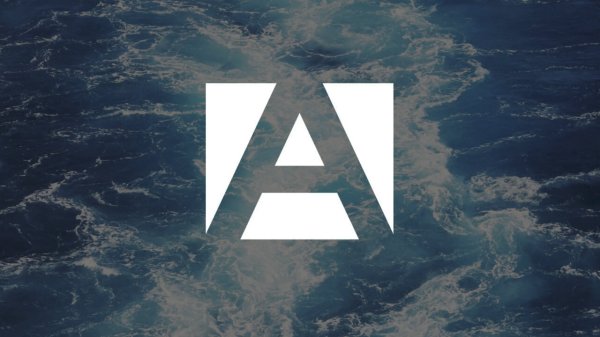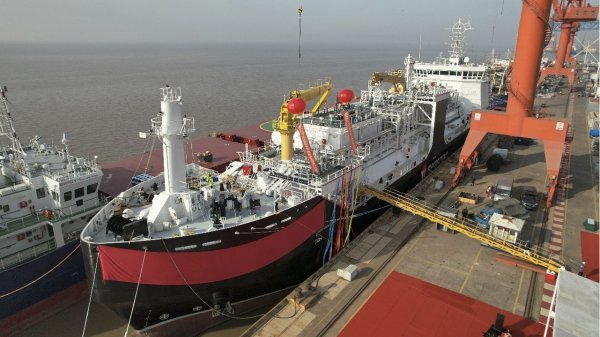Trelleborg supplies solutions to world's first floating LNG ship-to-shore system
Firm says collaboration showcases scope of applications for new LNG transfer infrastructure.
Trelleborg, a specialist in engineered polymer solutions, on Wednesday hailed the recent test of the Universal Transfer System (UTS) - conducted with Connect LNG and Gas Natural Fenosa - as tangible evidence of the new applications that its suite of products for jettyless LNG transfer can unlock.
The UTS transferred LNG from the Skangas-chartered LNG carrier Coral Energy to the onshore terminal at the Norwegian port of Heroya on October 7 and is now in full commercial operation.
A 'plug and play' solution, the UTS requires no modifications to the LNG carrier; instead, the platform maneuvers offshore to meet a vessel, removing the need for costly and environmentally intensive dedicated small/medium-scale LNG vessel harbour and jetty structures.
The system consists of Trelleborg's Cryoline LNG hoses, attached to a floating platform, which incorporates Trelleborg's ship-shore link technology and a selection of its marine fender systems.
Vincent Lagarrigue, Director of Trelleborg's oil and marine operation, commented: "The UTS shows that LNG infrastructure doesn't need to be bound by the same thinking that underpins transfer solutions for fossil-based energy. Instead, it demonstrates how new ideas are creating the foundations for safe, efficient and convenient infrastructure that can keep pace with the rapid evolution of the LNG market, both as a power source and marine fuel."
Magnus Eikens, Chief Commercial Officer of Connect LNG, remarked: "Trelleborg's expertise in fluid handling and LNG transfer has made it an invaluable partner in this project. The Cryoline LNG hose is an integral part of this solution, thanks to its durability, flexibility, and safety features. What’s more, its ship-shore link technology and marine fender expertise is vital in supporting UTS LNG transfer operations."
Richard Hepworth, President of Trelleborg's marine systems operation, said: "The UTS is an important forward thinking development. Our Universal Safety Link (USL) and the Sea Guard and Super Cone fenders are used in many LNG applications already. Integrating them into such an innovative solution as this will help ensure the safe, efficient transfer of LNG into markets and locations that would have previously been considered uneconomic. We are proud to be part of a project that promotes the expansion of the LNG value chain."
Jose Miguel Moreno, Director at Gas Natural Fenosa, commented: "The innovation demonstrated by Trelleborg and Connect LNG has delivered a game-changing solution for the LNG industry. We now have a market-ready system that opens a world of possibilities in the LNG small and medium scale business thanks to this collaboration."
The UTS increases the operability of an LNG terminal, as the hose and platform can be retracted when not needed, or when harsh weather conditions would present hazards. The platform-based solution can either function as a standalone unit, or enhance a larger terminal's ability to handle deliveries to and from a broader range of vessels. Trelleborg service engineers were present during the first commercial LNG transfer of 400 cubic metres.
Cryoline is the first floating hose of its kind to receive EN1474-2 accreditation, using flexible rubber-bonded hose technology to minimize boil-off and withstand fatigue harsh environmental conditions. It also includes an integrated monitoring system using fiber-optic technology to provide additional safety.
Trelleborg also supplied its USL 8810 to monitor the LNG transfer process. A triple fiber optic, five pin SIGTTO and pneumatic system was supplied to ensure all round flexibility for the platform for any visiting vessel. A triple fiber optic, five pin SIGTTO and pneumatic system was supplied to ensure all round flexibility for the platform for any visiting vessel.
Trelleborg's Sea Guard fenders were specified for use at the front of the UTS to absorb berthing impact against the larger LNG vessel prior to attachment to the vessel. While to reduce the impact of the tug vessels on the UTS, Trelleborg's Super Cone (SCN) fenders were specified to enable the tugs to safely push the UTS from shore into position for transfer operations.
The UTS transferred LNG from the Skangas-chartered LNG carrier Coral Energy to the onshore terminal at the Norwegian port of Heroya on October 7 and is now in full commercial operation.
A 'plug and play' solution, the UTS requires no modifications to the LNG carrier; instead, the platform maneuvers offshore to meet a vessel, removing the need for costly and environmentally intensive dedicated small/medium-scale LNG vessel harbour and jetty structures.
The system consists of Trelleborg's Cryoline LNG hoses, attached to a floating platform, which incorporates Trelleborg's ship-shore link technology and a selection of its marine fender systems.
Vincent Lagarrigue, Director of Trelleborg's oil and marine operation, commented: "The UTS shows that LNG infrastructure doesn't need to be bound by the same thinking that underpins transfer solutions for fossil-based energy. Instead, it demonstrates how new ideas are creating the foundations for safe, efficient and convenient infrastructure that can keep pace with the rapid evolution of the LNG market, both as a power source and marine fuel."
Magnus Eikens, Chief Commercial Officer of Connect LNG, remarked: "Trelleborg's expertise in fluid handling and LNG transfer has made it an invaluable partner in this project. The Cryoline LNG hose is an integral part of this solution, thanks to its durability, flexibility, and safety features. What’s more, its ship-shore link technology and marine fender expertise is vital in supporting UTS LNG transfer operations."
Richard Hepworth, President of Trelleborg's marine systems operation, said: "The UTS is an important forward thinking development. Our Universal Safety Link (USL) and the Sea Guard and Super Cone fenders are used in many LNG applications already. Integrating them into such an innovative solution as this will help ensure the safe, efficient transfer of LNG into markets and locations that would have previously been considered uneconomic. We are proud to be part of a project that promotes the expansion of the LNG value chain."
Jose Miguel Moreno, Director at Gas Natural Fenosa, commented: "The innovation demonstrated by Trelleborg and Connect LNG has delivered a game-changing solution for the LNG industry. We now have a market-ready system that opens a world of possibilities in the LNG small and medium scale business thanks to this collaboration."
The UTS increases the operability of an LNG terminal, as the hose and platform can be retracted when not needed, or when harsh weather conditions would present hazards. The platform-based solution can either function as a standalone unit, or enhance a larger terminal's ability to handle deliveries to and from a broader range of vessels. Trelleborg service engineers were present during the first commercial LNG transfer of 400 cubic metres.
Cryoline is the first floating hose of its kind to receive EN1474-2 accreditation, using flexible rubber-bonded hose technology to minimize boil-off and withstand fatigue harsh environmental conditions. It also includes an integrated monitoring system using fiber-optic technology to provide additional safety.
Trelleborg also supplied its USL 8810 to monitor the LNG transfer process. A triple fiber optic, five pin SIGTTO and pneumatic system was supplied to ensure all round flexibility for the platform for any visiting vessel. A triple fiber optic, five pin SIGTTO and pneumatic system was supplied to ensure all round flexibility for the platform for any visiting vessel.
Trelleborg's Sea Guard fenders were specified for use at the front of the UTS to absorb berthing impact against the larger LNG vessel prior to attachment to the vessel. While to reduce the impact of the tug vessels on the UTS, Trelleborg's Super Cone (SCN) fenders were specified to enable the tugs to safely push the UTS from shore into position for transfer operations.

|
IMO approves pricing mechanism based on GHG intensity thresholds
Charges to be levied on ships that do not meet yearly GHG fuel intensity reduction targets. |
|
|
|
||

|
VARO Energy expands renewable portfolio with Preem acquisition
All-cash transaction expected to complete in the latter half of 2025. |
|
|
|
||

|
NYK trials biofuel in milestone coal carrier test
Vessel is used to test biofuel for domestic utility company. |
|
|
|
||

|
H-Line Shipping orders LNG bunkering vessel
Vessel with 18,000-cbm capacity to run on both LNG and MDO. |
|
|
|
||

|
How to engineer and manage green shipping fuels | Stanley George, VPS
Effective management strategies and insights for evolving fuel use. |
|
|
|
||

|
Swedish government bans scrubber wastewater discharges
Discharges from open-loop scrubbers to be prohibited in Swedish waters from July 2025. |
|
|
|
||

|
MAN Energy Solutions achieves 100% load milestone for ammonia engine
Latest tests validate fuel injection system throughout the entire load curve. |
|
|
|
||

|
Petrobras secures ISCC EU RED certification for B24 biofuel blend at Rio Grande
Blend consisting of 24% FAME is said to have been rigorously tested to meet international standards. |
|
|
|
||

|
Stolt-Nielsen to fully control Avenir LNG with acquisition
Share purchase agreement to buy all shares from Golar LNG and Aequitas. |
|
|
|
||

|
Bureau Veritas supports launch of CIMC SOE's LNG bunkering vessel
Handover of Seaspan Energy's cutting-edge 7,600-cbm vessel completed. |
|
|
|
||

